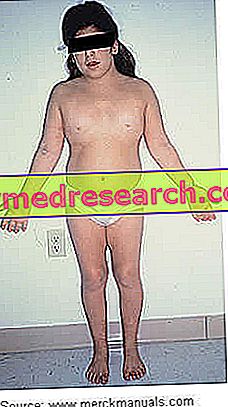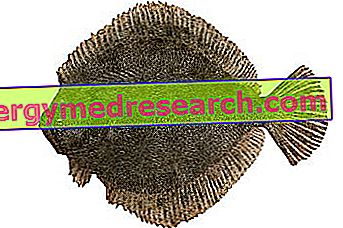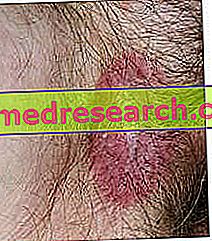Generality
Turner syndrome is a rare genetic disorder that only affects women. In most cases, DNA analysis of patients shows the absence of an X chromosome; therefore, instead of the normal copy of sex chromosomes XX, which characterizes the female sex, many women with Turner syndrome have a single X chromosome.

Unfortunately, there is no specific cure for Turner syndrome; however, treatments are available that are useful for curbing certain disorders and improving patients' quality of life.
To understand: human chromosomes
Each cell of a human being normally contains 23 pairs of chromosomes. A pair of these chromosomes is sexual, that is, it determines the sex of the individual; the remaining 22 pairs, instead, are composed of autosomal chromosomes. In all, therefore, the human genome has 46 chromosomes.
The alterations of the genes
Each pair of chromosomes contains certain genes .
When a mutation occurs in a chromosome, a gene can be defective. This defective gene consequently expresses a defective protein.
When the number of chromosomes varies, it is called aneuploidy . In these cases, instead of two, the chromosomes can be three (trisomy) or one only (monosomy).
Sex chromosomes
Sexual chromosomes are essential in determining a person's gender, male or female. The woman has, in the cells of her body, two copies of the so-called X chromosome ; the man, on the contrary, has an X chromosome and a Y chromosome.
As for the autosomal chromosomes, also the sexual ones are inherited from the parents: a copy is given by the father, another by the mother.
There are several genetic pathologies due to abnormal sex chromosomes. They show alterations in the chromosomal structure or changes in the number of chromosomes.
What is Turner Syndrome?
Turner syndrome is a genetic disease that affects only the female sex . In fact, the alteration concerns only one of the two sex chromosomes X; specifically, this chromosome is absent or partially complete. The genetic alteration can affect all cells of the body, or only part of them. In this case we speak of genome 45, X.
Women with Turner syndrome show mainly:
- Abnormalities at the level of the ovaries (female gonads), identified by the medical term gonadal dysgenesis .
- Particular somatic characters.
Epidemiology
Turner syndrome is not compatible with life and in most cases death occurs during gestation. However, some pregnancies still come to an end. Medical statistics show that every 2, 000 / 2, 500 born women are affected by Turner syndrome.
Causes
As already mentioned, the complete or partial absence of one of the two X chromosomes in the body's cells causes Turner syndrome. At this point, an interesting question to answer is: " What determines the loss of the X chromosome and when does it occur? "
Pathogenesis
The most accepted answer is the following. It seems that an error occurs during the process of mitosis of the fertilized egg. Mitosis is the division of a cell into two daughter cells. The error consists in the non-separation (or non-disjunction ) of one of the two sex chromatids, that is the sex chromosomes in the duplicated version. This means that one daughter cell will have three sex chromosomes (47, XXX or 47, XYY) and the other daughter cell will have only one X chromosome (45, X). The cell with three chromosomes does not survive; vice versa, that with only one chromosome continues to divide, maintaining the genetic defect.
Genetics: mosaicism
The moment of mitosis in which the non-disjunction error occurs, affects the genetic (genotype) aspect of women with Turner syndrome. In fact, if the error occurs at an early stage of the fertilized egg, you will have:
- Totally genotype 45, X. This means that all the cells of the body have only one X chromosome. We speak of X monosomy and it is observed in 60% of cases.
If, on the other hand, the error is at a later stage, when the fertilized egg has already started cell division, it will have:
- Partially genotype 45, X. This means that only a part of the body's cells contains an X chromosome; the remaining part of the cells is healthy (46, XX).
This condition is called genetic mosaicism (the mosaic is a figurative artistic composition, made up of many small pieces, each one different from the other).
The partial presence of 46, XX cells determines the same somatic and ovarian anomalies found in cases of total monosomy X. In other words, both genotypes are equally deleterious.
The mosaic is complicated
There is a percentage of women with an even more complicated genotype. To the cells 45, X and 46, XX, others are added, having:
- One of the two X chromosomes is incomplete.
Or
- A portion of the Y chromosome, independent or linked to other chromosomes.
Symptoms
To learn more: Symptoms Turner syndrome
Turner syndrome has a wide variety of symptoms and clinical signs. The age of the patient is an important factor; in fact, some disorders are characteristic of the prenatal and early childhood, others of adolescence and others of adulthood.
Prenatal age and early childhood
The most common symptom in prenatal age and in the first years of life is lymphedema . Lymphedema consists of a lymph stagnation in some parts of the body, both organs and tissues; this stagnation causes localized swelling .
In prenatal age, lymphedema affects the neck. There is talk of cystic hygroma . In childhood, lymphedema also extends to the hands and feet (ankles).
Adolescence and maturity
From early childhood to maturity, patients develop characteristic signs and symptoms of Turner syndrome. The anomalies and disturbances always present are the short stature and the immature, rudimentary ovaries.
- Short stature is a hallmark, as patients are much lower than their peers since the early years of childhood.
- Immature ovaries cause insufficient estrogen secretion, which makes normal pubertal development and possible pregnancy impossible.
Other typical signs, found in most patients, are the appearance of face, neck, chest and skin.
The following table shows the location of the sign, an in-depth analysis of the anomaly and the relative frequency among subjects affected by turner syndrome.
| Location of the sign / symptom | Anomalies: in-depth analysis | Frequency |
| Auxology (study of growth in developmental age) |
| 100% |
| Ocular apparatus |
| 20-39% |
| Auditory apparatus |
| 49-59% |
| Face |
| 60-79% |
| Integumentary system (skin and appendages) |
| 60-79% |
| Neck |
| 60-79% |
| Chest |
| 60-79% |
| Skeleton |
| 40-59% |
| Cardiovascular system |
| 40-50% |
| Urinary system |
| 40-59% |
| Reproductive system |
| 80-100% |
| Intellect |
| <10% |
Complications of adulthood
Over the years, Turner syndrome can lead to a series of complications, the result of an evolution of the aforementioned signs. Sometimes, these are unavoidable circumstances.
The main concerns are abnormalities in the aorta and heart . In fact, there is the risk of a dilation, which can degenerate into rupture, of the main artery of the human circulatory system, as well as the malformation of the aortic valve, which from a tricuspid becomes bicuspid.
Below are the complications and related descriptions.
| Complication | deepening |
| Cardiac abnormalities |
|
| Circulatory system problems |
|
| Renal anomalies |
|
| Eye problems |
|
| Hearing problems |
|
| Osteoporosis |
|
| Associated diseases |
|
Diagnosis
Certain prenatal or early childhood characteristics, such as lymphedema, neck folds and short stature (compared to peers), lead to suspect Turner syndrome. However, for a certain diagnosis it is necessary to resort to a genetic test, known as karyotype .
karyotype
It consists in the analysis of chromosomes present in a blood sample from a patient. In the case of Turner syndrome, the sample can be obtained by:
- Removal of the amniotic fluid surrounding the baby in the uterus.
- Blood sampling in the infant.
If one of the two X chromosomes is absent or incomplete, the diagnostic suspicion based on the typical signs of Turner syndrome is confirmed.
Other useful tests
Turner syndrome, as we have seen, causes numerous signs and complications. These must be carefully monitored over time, to avoid their irreversible degeneration. Therefore, periodic clinical tests and checks are recommended to improve the patient's quality of life.
Below is a table showing the test and why it is recommended.
| Test | Why? |
| Blood tests | To check annually:
|
| Hearing evaluation | To check annually:
|
| Eye exam | To check annually:
|
| Cardiological examination | Perform periodically:
|
| Renal examination | Ultrasound:
|
| Evaluation of skeletal growth |
|
| Weight control and physical exercise practice |
|
| Dental check |
|
Therapy
Since the cause of Turner syndrome is a genetic defect, inherent from birth, there is no cure. However, it is possible to stem part of the disorders by means of a hormonal pharmacological treatment coupled with physiotherapy . Furthermore, the psychological aspect should not be underestimated: patients with Turner syndrome, in fact, may not accept the conditions of sterility, short stature, etc. and should therefore be supported and helped.
Hormonal treatment
It is based on the administration of:
- Growth hormone (GH).
- Sex hormones.
- Estrogen.
- Progesterone.
Growth hormone ( GH ). It begins to be administered as early as the first or second year of life. The aim, of course, is to promote patient growth. The therapy is fairly successful. In the past, available GH was limited and its use posed risks: in fact, it was extracted from the pituitary gland of the corpses, which could be carriers of some infectious pathology. Since the mid-1980s, use has been made of GH synthesized in the laboratory thanks to biotechnology and therefore lacking the aforementioned infectious risks.
Growth hormone treatment should be done daily and lasts up to around 14 years, an age when a woman concludes growth in height.
A possible side effect relates to hyperglycemia caused by GH. In fact, patients with Turner syndrome are prone to diabetes mellitus.
| Characteristics of GH treatment | Description |
| dosage | Once a day, until the end of statural growth (14 years); Route of administration:
|
| Side effects | Hyperglycemia. |
| Result | Discreet. The sooner the therapy starts, the more the stature defect is limited. |
| History | Until the early 1980s, GH extracted from corpses was used. After that, only biosynthetic GH. |
Sex hormones . The administration of sex hormones is essential to ensure the pubertal development of patients. In fact, these hormones are not produced by the immature ovaries due to the pathology. The start of treatment must coincide with the onset of puberty. In any case, it must not start after 13 years of life. The route of administration can be both oral and transcutaneous (through the application of a plaster). Estrogen is associated with a progesterone treatment, necessary to induce and regulate the menstrual cycle.
Furthermore, estrogens have important effects in limiting the osteoporosis of young women with Turner syndrome.
| Features of estrogen treatment | Description |
| Why? | To remedy the insufficient function of immature ovaries. |
| Purpose | Promote pubertal development:
|
| dosage | The start of treatment must coincide with the beginning of pubertal development (12-13 years). It usually lasts for a lifetime. There are two possible routes of administration:
|
| Other effects | Limit osteoporosis. |
| Associations with other drugs | Progesterone. |
| Characteristics of progesterone treatment | Description |
| Purpose | Induce and regulate the menstrual cycle. |
Physiotherapy treatment
It consists of the use of elastic stockings. They are used to limit swelling in the lower limbs (ankles) due to lymphedema.
Psychological treatment
Women with Turner syndrome tend to have low self-esteem. In fact, they suffer from depression, due to the lack of:
- Normal reproductive system.
- Secondary sexual characters.
- Sterility.
- Normal sex life.
- Short stature and physical anomalies.
Therefore, it is useful that the doctor and those who live with the patients pay maximum attention in presenting the pathology that afflicts them. To improve the quality of life of patients and overcome the inferiority complex, they are important:
- The reassurance that, through correct hormonal therapy, it is possible to alleviate the most serious disorders.
- Psychological support.
- Comparison with other (older) women with Turner syndrome.
In this case, drugs such as:
- anxiolytics
- Antidepressants.
Sex education
Patients who can give birth to a child are rare. These should be instructed on the dangers of their pregnancy (for example, cardiac stress) and should be informed about available contraceptive methods.
For those who cannot have children, there is the possibility of assisted reproduction . Also in this case, they should be informed of the side effects.
Support and learning difficulties
It has long been thought that women with Turner syndrome had learning difficulties due to an inferior IQ. This is not true, except for rare cases. Intellectual abilities are usually normal. Therefore, their support is almost never necessary during the school years.
Prognosis
Today, patients' quality of life has greatly improved. Thanks to modern hormonal therapies and early diagnosis, physical deficits due to the disease can be improved. Periodic analyzes and the ease with which they can be performed are also important. This allows, in fact, to monitor the evolution of Turner syndrome step by step and prevent the most serious complications.



